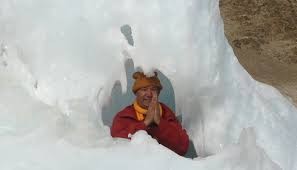Phyang Monastery face climate change with “Ice stupas”
In an interesting move, the traditional monastery is helping people face and dare the cliemate change issues that are cropping up in the region of Ladak. They are build ice stupas that helps water supply for the Himalayan terrains.
Traditional Buddhist monuments are bringing life to a Himalayan community grappling with climate change.

Villagers in Northern India have invented a way to fight drought, inspired by traditional Buddhist architecture. Each winter since 2013, the people of Phyang, Ladakh, have built stupas — traditional Buddhist monuments — made out of ice. When the weather warms and drought strikes in the springtime, the stupas melt and irrigate thousands of trees in the Himalayan desert.

 Stupas dot the Buddhist world. The stupa’s shape represents the body of the Buddha, and the monuments serve as objects of meditation and devotion for Buddhist practitioners.
Stupas dot the Buddhist world. The stupa’s shape represents the body of the Buddha, and the monuments serve as objects of meditation and devotion for Buddhist practitioners.
Sonam Wangchuk and two students crouched around a sapling. The “ice stupas” are the invention of engineer Sonam Wangchuk, who created them as a way to fight the effects of climate change, which causes extreme flooding and droughts in the Himalayas. For villagers in mountain deserts, water supply is a matter of life and death.
In the winter, Ladakh has plenty of water that goes unused. In the spring, the rivers go dry as all the farmers start planting their crops. Wangchuk’s ice stupas store water in the winter by freezing it in giant conical towers, which melt slowly due to their geometry.
To build the ice stupa, the workers put a pipe in a river, run it downhill to a dry field, and point the end upward. Around the mouth of the pipe, they build a latticework of dry brush to act as a skeleton. At night, when the temperature drops, they open the valve. Gravity forces water through the pipe at high pressure and shoots a frosty spray skyward, freezing around the dry brush.
Within weeks, the tower grows tens of meters skyward. The project requires no pumps, electricity, or moving parts, and the artificial glacier provides quenching meltwater for months, lasting almost until the summer rains arrive.
The project is managed by a monk from the local monastery and overseen by the head of the Drikung Kagyu School of Buddhism. Local villagers celebrated the success of the first ice stupas by decorating them with religious prayer flags, which aid the formation of ice crystals and shelter the stupa from wind.
This past winter, Wangchuk’s team built an ice stupa 78 feet tall — unofficially the world’s tallest manmade ice structure. Wangchuk estimates that a full-sized ice stupa could store ten million liters of water — enough to irrigate 20,000 trees. His dream is to build dozens of ice stupas, grow a forest in the desert, and use profits from the project to start a university devoted to adaptation and innovation in the Himalayas, offering courses in farming, tourism, and business.
Wangchuk also notes that the ice stupas become part of the local ecosystem. In a Facebook post, he wrote that he found a magpie nesting in the shelter of a melting stupa.
Last year, Wangchuk received the prestigious Rolex Award for the project, which comes with a 100,000 Swiss Franc prize. He pledged the prize money to the university project.
Conservationists in Europe have also taken interest in the project, and Wangchuk has been asked to pilot an ice stupa project in Switzerland to conserve retreating glaciers in the Alps.










